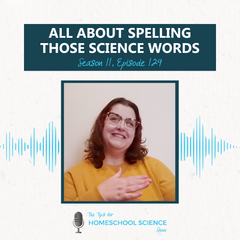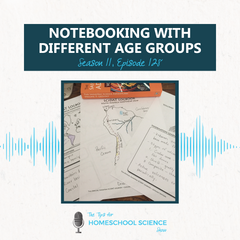FREE Shipping on all our products! (Please Note: Orders may experience a delay of a week or more in shipping due to the high volume of orders at this time of year.)
FREE Shipping on all our products! (Please Note: Orders may experience a delay of a week or more in shipping due to the high volume of orders at this time of year.)
Writing in Homeschool Science: The Elementary Years {Episode 12}
September 05, 2016 2 min read
Episode 12 – Writing in Homeschool Science: The Elementary Years
One of the three keys to teaching science is to keep a record. But what does writing in science look like? In episode 12 of the Tips for Teaching Science at Home Show, I am sharing the first part of a two-part series on tips for writing in science. This episode will look at the elementary years.
Watch the Video
Or listen to the audio
Share the Tips
If you found these homeschool science tips to be helpful, would you please take a moment to rate it on iTunes or Stitcher? This would help me tremendously in getting the word out, so that more ear buds are filled with science-teaching encouragement.
The Highlights
During the early years, I believe that writing in science goes through three stages – oral, transition, and composition.
Stage 1 – Oral
- Students are focusing on the learning how to form their letters on paper.
- They won’t be doing any physical writing, only oral narrations.
- You will discuss the reading selection, ask for an oral narration, write down their narrations, and read it back to them.
Stage 2 – Transition
- Students are learning the mechanics of spelling and grammar.
- They will be copying a portion or all of their narrations.
- You will still discuss the reading selection, ask for an oral narration, write down their narrations, and read it back to them before they begin copying.
Stage 3 – Composition
- Students are working on getting their thoughts on paper in a more cohesive manner.
- They will be writing down their narrations with the goal of writing 3 to 4 sentences on the subject.
- You will continue to discuss the reading selection and have them give an oral narration before writing.
The main thing you are looking for is consistent progress year after year.
Additional Resources
Don’t miss the following book to gain a broad picture of the progression of writing skills:
- The Complete Writer by Susan Wise Bauer
Here are several articles to read about writing in science:
- Science Essential #3 – Keeping a Record
- 3 Easy Steps for Notebooking
- How to Record an Experiment
- Did Charlotte Mason Espouse Notebooking?
Learn more about how you can teach science with our programs!
Also in {Podcast} The Tips for Homeschool Science Show
All About Spelling Those Science Words {Season 11, Episode 129}
March 25, 2024 7 min read

In this episode, we'll be interviewing Robin Williams from All About Spelling. Click "Read More" to listen is as we discuss tips and tricks for spelling all those science words!
How should you handle notebooking through the different ages? {Season 11, Episode 128}
March 18, 2024 3 min read

Writing in Science with a Well-Trained Mind (Interview) {Season 11, Episode 127}
March 11, 2024 16 min read

Click "Read More" to listen in as Susan Wise Bauer and Susanna Jarret join Paige to share tips and tools about the third key to teaching science!
Subscribe
Sign up to get the latest on sales, new releases and more …

